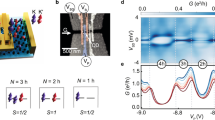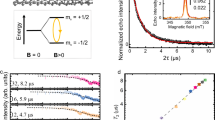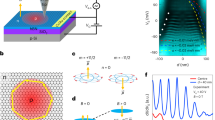Abstract
Understanding how the orbital motion of electrons is coupled to the spin degree of freedom in nanoscale systems is central for applications in spin-based electronics and quantum computation. Here we demonstrate such spin–orbit coupling in a carbon-nanotube quantum dot in the general multielectron regime and in the presence of finite disorder. Also, we find a systematic dependence of the spin–orbit coupling on the electron occupation of the quantum dot. Such a dependence has not been seen in any other system and follows from the curvature-induced spin–orbit-split Dirac spectrum of the underlying graphene lattice. Our findings suggest that the spin–orbit coupling is a general property of carbon-nanotube quantum dots, which should provide a unique platform for the study of spin–orbit effects and their applications.
This is a preview of subscription content, access via your institution
Access options
Subscribe to this journal
Receive 12 print issues and online access
$209.00 per year
only $17.42 per issue
Buy this article
- Purchase on Springer Link
- Instant access to full article PDF
Prices may be subject to local taxes which are calculated during checkout




Similar content being viewed by others
References
Bulaev, D., Trauzettel, B. & Loss, D. Spin–orbit interaction and anomalous spin relaxation in carbon nanotube quantum dots. Phys. Rev. B 77, 235301 (2008).
Fischer, J. & Loss, D. Dealing with decoherence. Science 324, 1277–1278 (2009).
Churchill, H. et al. Electron–nuclear interaction in 13C nanotube double quantum dots. Nature Phys. 5, 321–326 (2009).
Flindt, C., Sørensen, A. & Flensberg, K. Spin–orbit mediated control of spin qubits. Phys. Rev. Lett. 97, 240501 (2006).
Trif, M., Golovach, V. & Loss, D. Spin–spin coupling in electrostatically coupled quantum dots. Phys. Rev. B 75, 085307 (2007).
Nowack, K., Koppens, F., Nazarov, Y. & Vandersypen, L. Coherent control of a single electron spin with electric fields. Science 318, 1430–1433 (2007).
Pfund, A., Shorubalko, I., Ensslin, K. & Leturcq, R. Suppression of spin relaxation in an InAs nanowire double quantum dot. Phys. Rev. Lett. 99, 036801 (2007).
Kuemmeth, F., Ilani, S., Ralph, D. & McEuen, P. Coupling of spin and orbital motion of electrons in carbon nanotubes. Nature 452, 448–452 (2008).
Kuemmeth, F., Churchill, H., Herring, P. & Marcus, C. Carbon nanotubes for coherent spintronics. Mater. Today 13, 18–26 (March 2010).
Ando, T. Spin–orbit interaction in carbon nanotubes. J. Phys. Soc. Jpn 69, 1757–1763 (2000).
Chico, L., Lopez-Sancho, M. & Munoz, M. Spin splitting induced by spin–orbit interaction in chiral nanotubes. Phys. Rev. Lett. 93, 176402 (2004).
Huertas-Hernando, D., Guinea, F. & Brataas, A. Spin–orbit coupling in curved graphene, fullerenes, nanotubes, and nanotube caps. Phys. Rev. B 74, 155426 (2006).
Jeong, J. & Lee, H. Curvature-enhanced spin–orbit coupling in a carbon nanotube. Phys. Rev. B 80, 075409 (2009).
Izumida, W., Sato, K. & Saito, R. Spin–orbit interaction in single wall carbon nanotubes: Symmetry adapted tight-binding calculation and effective model analysis. J. Phys. Soc. Jpn 78, 074707 (2009).
Fasth, C., Fuhrer, A., Samuelson, L., Golovach, V. & Loss, D. Direct measurement of the spin–orbit interaction in a two-electron InAs nanowire quantum dot. Phys. Rev. Lett. 98, 266801 (2007).
Csonka, S. et al. Giant fluctuations and gate control of the g-factor in InAs nanowire quantum dots. Nano Lett. 8, 3932–3935 (2008).
Nilsson, H. et al. Giant, level-dependent g factors in InSb nanowire quantum dots. Nano Lett. 9, 3151–3156 (2009).
Flensberg, K. & Marcus, C. Bends in nanotubes allow electric spin control and coupling. Phys. Rev. B 81, 195418 (2010).
Liang, W., Bockrath, M. & Park, H. Shell filling and exchange coupling in metallic single-walled carbon nanotubes. Phys. Rev. Lett. 88, 126801 (2002).
Cobden, D. & Nygård, J. Shell filling in closed single-wall carbon nanotube quantum dots. Phys. Rev. Lett. 89, 046803 (2002).
Jarillo-Herrero, P. et al. Electronic transport spectroscopy of carbon nanotubes in a magnetic field. Phys. Rev. Lett. 94, 156802 (2005).
Makarovski, A., An, L., Liu, J. & Finkelstein, G. Persistent orbital degeneracy in carbon nanotubes. Phys. Rev. B 74, 155431 (2006).
Moriyama, S., Fuse, T., Suzuki, M., Aoyagi, Y. & Ishibashi, K. Four-electron shell structures and an interacting two-electron system in carbon-nanotube quantum dots. Phys. Rev. Lett. 94, 186806 (2005).
Oreg, Y., Byczuk, K. & Halperin, B. Spin configurations of a carbon nanotube in a nonuniform externalpotential. Phys. Rev. Lett. 85, 365–368 (2000).
Minot, E., Yaish, Y., Sazonova, V. & McEuen, P. Determination of electron orbital magnetic moments in carbon nanotubes. Nature 428, 536–539 (2004).
Jarillo-Herrero, P., Sapmaz, S., Dekker, C., Kouwenhoven, L. & van der Zant, H. Electron–hole symmetry in a semiconducting carbon nanotube quantum dot. Nature 429, 389–392 (2004).
De Franceschi, S. et al. Electron cotunneling in a semiconductor quantum dot. Phys. Rev. Lett. 86, 878–881 (2001).
Paaske, J. et al. Non-equilibrium singlet–triplet Kondo effect in carbon nanotubes. Nature Phys. 2, 460–464 (2006).
Hanson, R., Kouwenhoven, L., Petta, J., Tarucha, S. & Vandersypen, L. Spins in few-electron quantum dots. Rev. Mod. Phys. 79, 1217–1265 (2007).
Nygård, J., Cobden, D. & Lindelof, P. Kondo physics in carbon nanotubes. Nature 408, 342–346 (2000).
Galpin, M., Jayatilaka, F., Logan, D. & Anders, F. Interplay between Kondo physics and spin–orbit coupling in carbon nanotube quantum dots. Phys. Rev. B 81, 075437 (2010).
Kane, C. & Mele, E. Size, shape, and low energy electronic structure of carbon nanotubes. Phys. Rev. Lett. 78, 1932–1935 (1997).
Kleiner, A. & Eggert, S. Band gaps of primary metallic carbon nanotubes. Phys. Rev. B 63, 073408 (2001).
Chico, L., Lopez-Sancho, M. & Munoz, M. Curvature-induced anisotropic spin–orbit splitting in carbon nanotubes. Phys. Rev. B 79, 235423 (2009).
Kong, J., Soh, H., Cassell, A., Quate, C. & Dai, H. Synthesis of individual single-walled carbon nanotubes on patterned silicon wafers. Nature 395, 878–881 (1998).
Acknowledgements
We thank P. E. Lindelof, J. Mygind, H. I. Jørgensen, C. M. Marcus and F. Kuemmeth for discussions and experimental support. T.S.J. acknowledges the Carlsberg Foundation and Lundbeck Foundation for financial support. K.G-R., K.F. and J.N. acknowledge The Danish Research Council and University of Copenhagen Center of Excellence.
Author information
Authors and Affiliations
Contributions
T.S.J. and K.G-R. made the measurements, analysed the data and wrote the paper. T.S.J. designed the rotating sample stage. K.G-R. made the sample. K.M., T.F. and J.N. participated in discussions and writing the paper. J.P. and K.F. developed the theory and guided the experiment.
Corresponding authors
Ethics declarations
Competing interests
The authors declare no competing financial interests.
Supplementary information
Supplementary Information
Supplementary Information (PDF 1266 kb)
Rights and permissions
About this article
Cite this article
Jespersen, T., Grove-Rasmussen, K., Paaske, J. et al. Gate-dependent spin–orbit coupling in multielectron carbon nanotubes. Nature Phys 7, 348–353 (2011). https://doi.org/10.1038/nphys1880
Received:
Accepted:
Published:
Issue Date:
DOI: https://doi.org/10.1038/nphys1880
This article is cited by
-
Spin-valley coupling in single-electron bilayer graphene quantum dots
Nature Communications (2021)
-
Coherent population trapping by dark state formation in a carbon nanotube quantum dot
Nature Communications (2019)
-
Electrical control of spins and giant g-factors in ring-like coupled quantum dots
Nature Communications (2019)
-
Transport in serial spinful multiple-dot systems: The role of electron-electron interactions and coherences
Scientific Reports (2016)
-
Blocking transport resonances via Kondo many-body entanglement in quantum dots
Nature Communications (2016)



